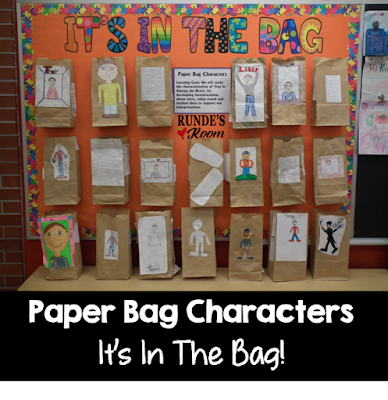OK. I've got my evaluation coming up this week. So ... I've spent the last week sprucing up my bulletin boards and posting new student work. And I must admit, the classroom is looking FANTASTIC (I hope). My Word Wall makeover was just the start. I'm very excited about my
"It's In The Bag" bulletin board. I wasn't sure the student projects would work as a bulletin board display - I was planning to display the projects on a table - but it worked ... well!
This year I've been reading the
Shadow Children series, by Margaret Peterson Haddix, as my oral read to the class. Normally, I would just read the first book of a series, knowing I'd spark enough interest for at least a few students to continue the series independently. Not this year, though. I have a boy in my class who has Aspergers and can be quite difficult to engage. He has sat, entranced with the novels, from the day I started the first book. Although he can't read indendently at this level, he is definitely comprehending the material at a very deep level, and his insights often WOW me! How could I not finish the series???
I use my oral reading sessions to spark deep conversations about the novel, and I model aloud the reading strategies I use. The only thing I require from my students during our reading of the novel is participation in our discussions. This has never been a problem. In fact, I often have to cut our conversations off 5 to 10 minutes AFTER the bell. At the end of each oral novel, I do have a summative task. These tasks are varied. We've had comprehension quizzes, book talks, made comic strips, written reading responses, etc. For our last novel (our fifth in the series), the students completed my
Paper Bag Character Study.
For this assignment, students were given a plain paper bag. On the front of the bag they had to draw an illustration of the main character. On one of the side panels they had to write about the character's likes and dislikes, and on the other side panel they had to write about how the character interacts with other characters in the novel. On the back panel the students had to write about how the character changed throughout the novel, and what events were responsible for the changes the character made. Our current reading focus is inferring, so this assignment fit perfectly. My favourite part of the assignment was what was "in the bag". Students had to put 10 objects in their bags that represented or reminded them of the main character. On the day the assignments were due, students orally presented the 10 objects they chose. I was
amazed by some of their choices. One student pulled a box from her bag, stating it represented the symbolic box the character had previously been trapped in. Another student included a poppy to symbolize the courage and bravery the character displayed. Yet another student (my student with Aspergers) pulled a book about Hitler from his bag, telling the students the autocratic regime in the book reminded him of Hitler and his control of Germany during WWII. (Did I mention his insights often WOW me?!). These are eleven and twelve year olds ... chills, I tell you!
This
Paper Bag Character Study is available in my TpT store. You can take a peek at it by clicking HERE or on the picture to the right.
A smaller, more condensed version of this assignment can be found in my
Characterization Bundle. The 29 page resource includes: a set of 3 mini-posters, bookmarks, a full page of activity ideas, a full page of reading response prompts, a page of internet resources, and a book list. It also contains many different reading and writing graphic organizers, as well as two full ready-to-use assignments, success criteria, and rubrics (1- paper bag character analysis, 2- character journal writing).
Characterization Bundle
This characterization bundle is also included in my much larger resource,
Literary Elements Resource. This HUGE 156 page resource contains creative resources and assignments to support your students’ learning of literary elements. Resources can be used to study ANY text. Literary elements included in this resource are:
• Author's Purpose
• Characterization
• Figurative Language
• Point of View
• Tone and Mood
Each literary element section (30 pages in each section) contains a set of colorful posters, bookmarks, a full page of class activity ideas, a full page of reading response prompts and questions, a page of internet resources, and a book list. Each section also contains a variety of resources for oral language, reading, and writing (anchor charts, handouts, graphic organizers, etc.), ready-to-use student assignments, and rubrics.
Literary Elements Resource







































